Read my CV
Click here for my Google Scholar profile.
Volcanology · Experimental Petrology · Volatiles in Magmas
Volcanoes are the ultimate expressions of Earth’s deep processes
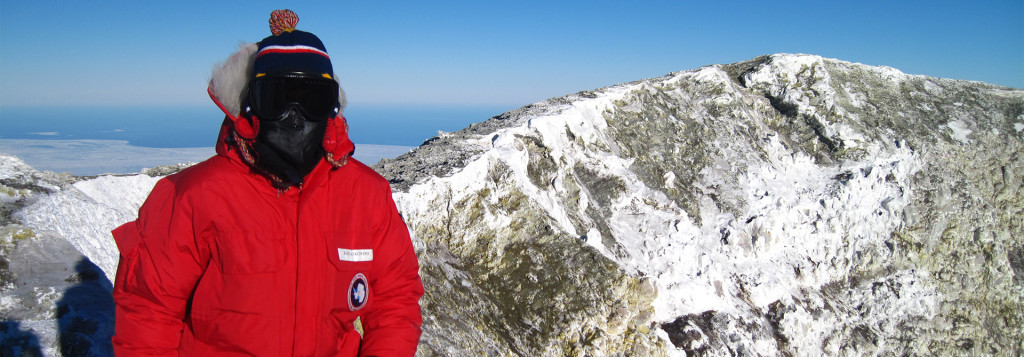
I use a combination of fieldwork, laboratory experiments, and thermodynamic modeling to better understand the inner workings of crustal volcanic systems. I am particularly interested in answering questions about how volcanic volatiles (H2O, CO2, S, F, Cl) cycle within the Earth and other planets and how a combination of magma crystallization, degassing, and chemical evolution leads to volcanic eruption. Volcanoes are notorious emitters of gases, many of which can have large impacts on Earth’s atmosphere and climate. The magmatic plumbing systems — the networks of magma “pipes” and chambers — that exist beneath volcanoes are the pathways through which such gases exsolve, evolve, and ultimately are transferred from mantle to surface.
The tools to read the rocks
The rock record tells the story of the Earth. Geologists learn how to read it.
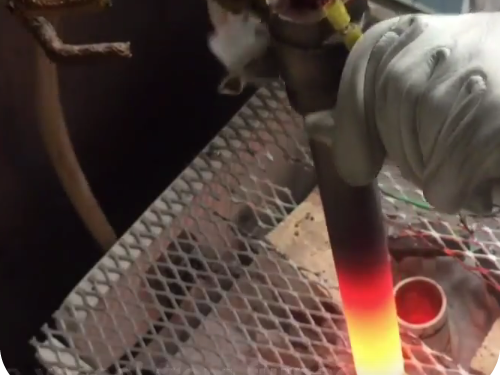
Experimental petrology techniques to recreate miniature magma chambers in the lab
In this way, we can gain insight into the subterranean processes driving volcanic activity directly observed at the Earth’s surface.
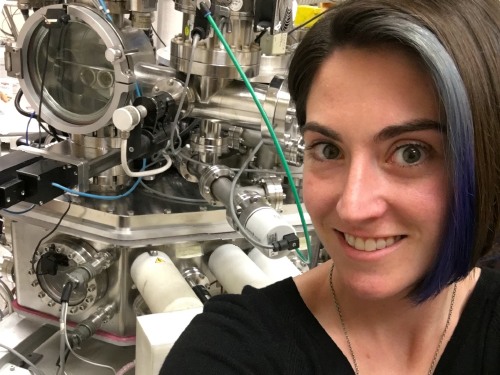
Analytical petrology to characterize rock samples
Igneous rocks record the histories of magma formation, crystallization, degassing, and more. I use geochemical analysis to unlock the mysteries stored within the rocks I study.
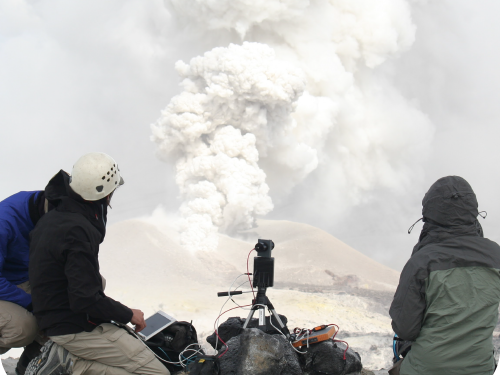
In situ and satellite remote sensing to measure volcanic degassing
In order to link subsurface to surface degassing, I utilize in situ volcanic remote sensing techniques (DOAS, UV Cameras, OP-FTIR, solar photometery) and satellite remote sensing (OMI and ALI instruments) to measure SO2 and other gas species emitted from active volcanoes.
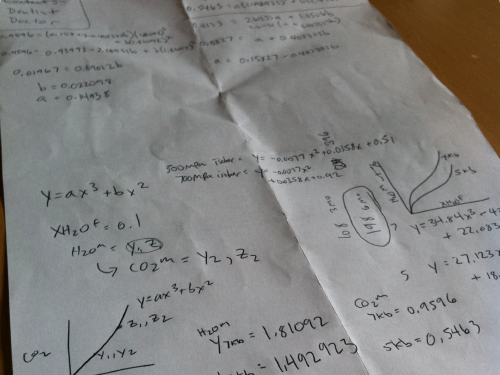
Thermodynamic modeling
Thermodynamics is the magical math that brings all of my interests together. Thermodynamics can be used to model crystallization and degassing processes within volcanic systems and can be used to constrain total volatile budgets of volcanoes.
Peer Reviewed Publications
2024
21. *Murray AN, Ort MH, Iacovino K, Smith VC, Giordano G, Isaia R (submitted) Evidence of shallow storage and re-equilibration of magmas feeding the 39.8 ka Campanian Ignimbrite (Italy) eruption. Submitted to Bulletin of Volcanology.
20. Anzures BA, Parman SW, Milliken RE, Namur O, Cartier C, McCubbin FM, Vander Kaaden KE, Prissel K, Iacovino K (submitted) An oxygen fugacity-temperature-pressure-composition model for sulfide speciation in mercurian magmas. Submitted to Geochimica et Cosmochimica Acta.
19. †Crossley SD, Setera JB, †Anzures BA, Iacovino K, Buckley WP, Eckley SA, O’Neal EW, Maisano JA, Simon JI, Righter K (submitted) Percolative sulfide core formation in oxidized planetary bodies. Submitted to Science Advances.
2023
18. Gallo RI, Ort MH, Iacovino K, Silleni A, Smith V, Giordano G, Isaia R, Boro J (2023) Reconciling complex stratigraphic frameworks reveals temporally and geographically variable depositional patterns of the Campanian Ignimbrite. Journal of Volcanology and Geothermal Research, https://doi.org/10.1130/GES02651.1
17. Iacovino K, McCubbin FM, Vander Kaaden KE, Clark J, Wittmann A, Jakubek RS, Moore GM, Fries MD, Archer D, Boyce JW (2023) Carbon as a key driver of super-reduced explosive volcanism on Mercury: Evidence from graphite-melt smelting experiments. Earth and Planetary Science Letters, doi: 10.1016/j.epsl.2022.117908
16. Righter K, Butterworth A, Gainsforth Z, Jilly-Rehak J, Roychoudhury S, Iacovino K, Rowland R, Erickson T, Pando K, Ross DK, Prendergast D, Westphal A (2023) Oxygen fugacity buffering in high pressure solid media assemblies from IW-6.5 to IW+4.5 and application to the V K-edge oxybarometer. American Mineralogist, doi: 10.2138/am-2022-8301
2022
15. Wadsworth FB, Llewellin EW, Castro JM, Tuffen H, Schipper CI, Gardner JE, Foster A, Vasseur J, Damby DE, McIntosh IM, Boettcher S, Unwin HE, Heap MJ, Farquharson JI, Dingwell DB, Iacovino K, Paisley R, Jones C, Whattam J (2022) A reappraisal of explosive-effusive silicic eruption dynamics: syn-eruptive assembly of lava from the products of cryptic fragmentation. Journal of Volcanology and Geothermal Research, doi: 10.1016/j.jvolgeores.2022.107672
14. Wieser PE, Iacovino K, Moore GM, Matthews S, Allison CM (2022) VESIcal Part II: A critical approach to volatile solubility modeling using an open-source Python3 engine. Earth and Space Science, doi: 10.1029/2021EA001932
2021
13. Iacovino K, Matthews S, Wieser PE, Moore GM, Bégué F (2021) VESIcal Part I: An open-source thermodynamic model engine for mixed volatile (H2O-CO2) solubility in silicate melts. Earth and Space Science. doi: 10.1029/2020EA001584
12. Wieser PE, Lamadrid H, Maclenna J, Edmonds M, Matthews S, Iacovino K, Jenner F, Gansecki C, Trusdell F, Lee L, Ilyinskaya E (2021) Reconstructing magma storage depths for the 2018 Kilauean eruption form melt inclusion CO2 contents: The importance of vapor bubbles. G3. doi: 10.1029/2020GC009364
2020
11. Iacovino K, Guild MR, Till CB (2020) Aqueous fluids are effective oxidizing agents of the mantle in subduction zones, Contributions to Mineralogy and Petrology. doi: 10.1007/s00410-020-1673-4
10. Edmonds M, Tutolo B, Iacovino K, Moussallam Y (2020) Magmatic carbon outgassing and uptake of CO2 by alkaline waters, American Mineralogist. doi: 10.2138/am-2020-6986CCBY.
2019
9. Ojha L, Karunatillake S, Iacovino K (2019) Atmospheric injection of sulfur from the Medusae Fossae forming events, Planetary and Space Science. doi: 10.1016/j.pss.2019.104734.
8. Iacovino K, Till CB (2019) DensityX: A program for calculating the densities of magmatic liquids up to 1,627 °C and 30 kbar, Volcanica 2(1), pp. 1-10. doi: 10.30909/vol.02.01.0110.
7. Barry PH, de Moor J, Giovannelli D, Schrenk M, Hummer D, Lopez T, Pratt C, Alpízar Segura Y, Battaglia A, Beaudry P, Bini G, Cascante M, d’Errico G, di Carlo M, Fattorini D, Fullerton K, Gazel E, González G, Halldórsson S, Iacovino K, Ilanko T, Kulongoski J, Manini E, Martínez M, Miller H, Nakagawa M, Ono S, Patwardhan S, Ramírez C, Regoli R, Smedile G, Turner S, Vetriani C, Yücel M, Ballentine C, Fischer T, Hilton D, Lloyd K (2019) Forearc carbon sinks reduce long-term volatile recycling into the mantle, Nature, v. 586, p. 487- 492. doi: 10.1038/s41586-019-1131-5
2018
6. Lowenstern JB, van Hinsberg V, Berlo K, Liesegang M, Iacovino K, Bindeman I, Wright H (2018) Opal-A in Glassy Pumice, Acid Alteration, and the 1817 Phreatomagmatic Eruption at Kawah Ijen (Java), Indonesia, Frontiers in Volcanology 6:11. doi: 10.3389/feart.2018.00011
2016
5. Iacovino K, Kim JS, Sisson T, Lowenstern J, Ri KH, Jang JN, Song KH, Ham HH, Oppenheimer C, Hammond JOS, Donovan A, Weber-Liu K, Ryu KR (2016) Quantifying gas emissions from the ‘Millennium Eruption’ of Paektu volcano, Democratic People’s Republic of Korea/China. Science Advances. doi 10.1126/sciadv.1600913
4. Ri KS, Hammond JOS, Ko CN, Kim H, Yun YG, Pak GJ, Ri CS, Oppenheimer C, Weber-Liu K, Iacovino K, Ryu KR (2016) Evidence for partial melt in the crust beneath Mt. Paektu (Changbaishan), Democratic People’s Republic of Korea/China. Science Advances. doi: 10.1126/sciadv.1501513
3. Iacovino K, Oppenheimer C, Scaillet B & Kyle PR (2016) Storage and evolution of mafic and intermediate alkaline magmas beneath Ross Island, Antarctica. Journal of Petrology doi:10.1093/petrology/egv083
2015
2. Iacovino K (2015) Linking subsurface to surface degassing at active volcanoes: A thermodynamic model with applications to Erebus volcano. Earth and Planetary Science Letters. doi:10.1016/j.epsl.2015.09.016
2013
1. Iacovino K, Moore G, Roggensack K, Oppenheimer C & Kyle P (2013) H2O–CO2 solubility in mafic alkaline magma: applications to volatile sources and degassing behavior at Erebus volcano, Antarctica. Contrib Mineral and Petrol. doi:10.1007/s00410-013-0877-2
Education
I am a classically trained experimental petrologist working for Jacobs at NASA Johnson Space Center, Astromaterials Research and Exploration Science (ARES) department in Houston, Texas. I use high-pressure and high-temperature apparatus to make mini magma chambers in the laboratory to study why volcanoes erupt on Earth and on other planetary bodies.
I received my Bachelors of Science in Geology from Arizona State University in 2010 where I worked in the OmniPressure experimental lab (aka Depths of the Earth) under the supervision of Dr. Gordon Moore. In 2014 I received my PhD from the University of Cambridge in Cambridge, UK studying Mt. Erebus, an active volcano located on Ross Island, Antarctica with Dr. Clive Oppenheimer. From 2014–2016 I was an NSF post-doctoral fellow at the US Geological Survey in Menlo Park, California studying the ‘Millennium Eruption’ of Paektu volcano, located on the border between North Korea and China with Drs. Tom Sisson and Jake Lowenstern. From 2016-2018 I was a post-doctoral researcher at Arizona State University in Tempe, Arizona working with Drs. Christy Till and Ariel Anbar studying how redox potential may be transferred into the deep Earth and back to the surface in arc magmas.
I have worked on San Carlos, Arizona; Villarrica, Puyehue, and Lascar in Chile; Peaktu, North Korea/China; Turrialba and Poas, Costa Rica; Erebus volcano, Antarctica; Nyiragongo and Nyamulagira in the Democratic Republic of Congo; and Campi Flegrei in Naples, Italy. I have done experimental work at Johnson Space Center, the US Geological Survey in Menlo Park, CA, Stanford University, the OmniPressure Lab (Depths of the Earth) and the EPIC lab at Arizona State University, the University of Minnesota Experimental Petrology Group, the Institut des Sciences de la Terre d’Orleans (ISTO), and the experimental petrology lab at Università di Camerino.
Current Projects
Quantifying Sampling Depth Bias in Planetary Interiors: An
Experimental Investigation On The Survival Of Melt Inclusions
NASA ROSES Solar System Workings (PI, $454,942)
Melt inclusions (MI) are micron-scale blebs of silicate melt (± crystals ± vapor) that become entrapped within growing crystals in planetary interiors, providing critical snapshots of a rock’s history and provenance by being sequestered from secondary processes affecting their host rocks. Glassy MI, if well preserved, allow direct measurement of pre-eruptive volatile contents (H2O, CO2, S) of igneous rocks, which are often used to estimate bulk volatile contents of rocky bodies. However, the mechanisms of MI formation and survival remain poorly understood, leading to uncertainties about their representativeness of magmatic systems. A key challenge is understanding why some MI fail to survive ascent to the surface, leaving no evidence of their prior existence, which may introduce preservation bias into the rock record. This bias, particularly in interpretations of maximum water contents in MI as proxies for planetary bulk values, underscores the need to evaluate the MI record in its proper context. To address this, we are conducting a systematic laboratory study to determine the conditions under which MI survive. Ongoing experiments involve heating MI-bearing crystals from terrestrial analog samples to rupture in a controlled heating stage and observing their behavior with high-speed cameras. Early results are contributing to the development of a thermodynamically backed empirical model that incorporates MI composition, geometry, host crystal structure, volatile exsolution, and pressure- and temperature-induced density changes. We are analyzing experimental samples for volatile and major element chemistry using infrared spectroscopy, Raman calibration, and electron microprobe techniques, while x-ray computed tomography is being used to document pre- and post-destruction MI characteristics. By testing diverse terrestrial MI suites, this study is refining our understanding of the upper limits on extraction depths and volatile contents of MI that survive ascent, shedding light on potential underestimations of planetary volatile contents in current studies and identifying planetary bodies for which MI provide unbiased records of bulk volatile concentrations.
Exploration of Igneous Rocks at the Surface of Mars
Combining Experimental Petrology and Remote Sensing
NASA ROSES Solar System Workings (Co-I, $492,599)
The complexity of Mars magmatism is becoming increasingly evident through rover analyses, martian meteorites, and remote sensing data, but significant gaps remain in our understanding of the planet’s magmatic history. Remote sensing offers a global view of Mars’ volcanic mineralogy but is limited by large spatial resolution and reliance on spectral libraries derived from terrestrial rocks, which are not fully representative of martian igneous compositions. To address these limitations, we are conducting a systematic study combining experimental petrology and spectroscopy to bridge the gaps between remote sensing data and physical samples from Mars. Ongoing 1-atm crystallization experiments are producing Mars-like igneous analogs with varying mineralogy and grain sizes, mimicking the compositions observed in martian volcanic terrains. These samples are being analyzed with VNIR and MIR spectroscopy to assess the reliability of spectrally inferred petrologic interpretations. Experimental results are compared with remote sensing data from volcanic terrains such as Syrtis Major Planum and Jezero crater to evaluate the accuracy and limitations of current spectral models. This research is already expanding spectral libraries to include Mars-relevant compositions and grain sizes and is critically assessing whether terrestrial spectral end-member libraries bias interpretations of Mars’ volcanic mineralogy. By combining experimental and remote sensing approaches, our work is refining methods for characterizing martian volcanic terrains and providing new insights into Mars’ magmatic history, laying the groundwork for future improvements in deconvolution models and spectral libraries.
Tracking volatile sources in the solar system
Volatiles (H, C, F, Cl) are important drivers of geologic and biologic processes, and the rock record may be used to constrain how these crucial elements were distributed in the solar system. Silicate (e.g., olivine) and phosphate minerals (e.g., apatite, merrillite) are ubiquitous in extraterrestrial rocks and are commonly used as robust recorders of volatile storage and transport processes. But many of the techniques and equations developed to interpret these crystal records have been calibrated for conditions common on Earth. It is not well known whether these same calibrations may be applied to some rocks from extraterrestrial bodies, which may have pressure, temperature, oxygen fugacity, and chemical characteristics quite distinct from those common on Earth. I am leading two experimental studies to extend our parameterization of volatile records in: a) Ca-rich olivines; and b) rocks multiply saturated in apatite and merrillite. New equations for the interpretation of extraterrestrial crystal records will be applied to lunar samples and water-bearing bodies such as angrite meteorites.
Physical and chemical constraints on large-volume pyroclastic blasts: The Campanian Ignimbrite eruption, Italy
Investigation of the Campanian Ignimbrite (Italy) to constrain physical and chemical parameters associated with gas release and ignimbrite emplacement of large-volume pyroclastic blasts. Proposed work includes: 1) detailed field investigations to better characterize the Campanian Ignimbrite stratigraphy to link distal and proximal deposits and to define the relative timing of volcanic events; and 2) a detailed petrologic study of CI products, notably by performing complete volatile analysis (H2O, CO2, S, F and Cl) of melt inclusions and apatite microphenocrysts.